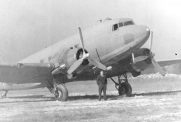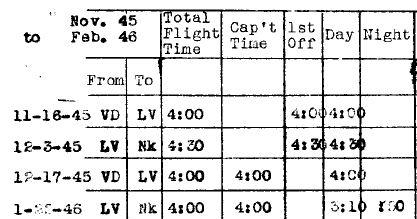DC-3 ops documents prove it’s no fly-by-night outfit

I want to share Robert Chambers‘ Veterans Air DC-3 ops documents. Given to me during my first get-together with Bruce Chambers in May, they are informative and insightful. [Quick review: Bruce is Robert’s second son. And Robert Chambers was DC-3 Chief Pilot for Veterans Air.]
Among the documents are:
- Memo dated 26 March 1946, SUBJECT: Ground Training Familiarization with a 7-page attachment.
- Equally-long DC-3 Cockpit Procedure and Check List.
- Captain Chambers’ Running Log.
- Stockholder letters and Business Plans (subject for later Post)
4 hours: VD to LV in the DC-3. Where’s VD?
Chambers’ pilot log has some unfamiliar two-letter airport identifiers and very confirming information regarding where we flew.
CHAMBERS-Robert-C_Pilot-Running-Log_11-16-1945_2-25-1946_3I figured out that MM is Miami and NK is Newark. A great site on line – airliners.net – identified LV for me as Louisville (which was definitely a Veterans Air destination). But so far we have no identification for VD. To see if airliners.net can help further (unless you, Dear Reader, beat them to it), I posted some flight stats on their site that show it took four hours in the DC-3 to fly between VD and LV.
I just this moment realized that the log does not indicate the airplane being flown. But since Robert was the Chief Pilot for the DC-3s, I’ll make that assumption. It would’ve been fun to know the tail number, because I’m always in search of our crews that flew the DC-3 GAYE LYN. (I can’t help myself.) (Oh! how I wish we had other logs. Remember the excitement created by having Jack Stettner’s logs???)
Not scintillating, but certainly serious!
These documents are not exactly scintillating reading. But their very existence is what strikes me. While they flew passengers and cargo at night, Veterans Air was hardly a fly-by-night organization. From other research and this hard evidence in Chambers’ file, we see emphasis on procedures and safety, and an insistence on professionalism. They may have been short on funding, but they worked without pay before they would think of short shrifting or cutting corners on the operation.
Sound familiar to you DC-3 aviators and enthusiasts?
Open door on the floor to give quick access to engine selector valve and fire extinguisher handle. Close door after both engines have started and you are satisfied there is no fire in either nacelle by visual observation. (Starting of Engines, pg 1)
Before commencing the turn, unlock the tail wheel. (Taxiing, pg 3)
The Captain will always determine the time at which the landing gear is to be raised and in no case shall the First Officer attempt to raise the gear unless he has received proper signal from the Captain. (Take off, pg 5)
Maintain 120 MPH indicated airspeed in cruising climb. (Climb to Cruising Altitude, pg 6)
And my favorite…
All members of the flight shall conduct themselves in a quiet, orderly and businesslike manner. (Landing Accomplished, pg7)
Veterans Air DC-3 Check List. Take a discovery flight!
I think there are DC-3 aviators and enthusiasts out there who may enjoy more than excerpts. So let’s go to the full document.
VeteransAirExpressC0_DC-3_Cockpit-Procedure-and-Checklist_1945

